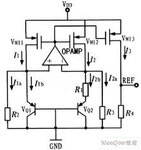DJP1992
Newbie level 5

Hi ,everyone i am trying to design a low voltage BGR.I am using 90nm Technology with 1v supply and vref is 700mV.Eventhough,I am getting variation of around 8mV across corners(SS,NN,SF,FS,FF) but vref curve is inverted parabola(i.e. U)(vref v/s temp).I am not able to figure out what may be the possible reason.Can anyone help me out.
Obtained output:
Phase margin=72 deg
PSRR=-38dB
IS the output acceptable or is it compulsory that we must get normal parabola(inverted U) curve.